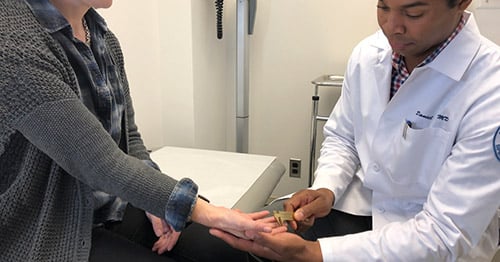Carpal Tunnel Syndrome – Causes, Diagnosis, Treatments
People commonly associate the development of carpal tunnel syndrome with longstanding computer use. In reality, typing on a keyboard is rarely if ever the “cause” of carpal tunnel syndrome. Moreover, almost anyone can develop the condition. In fact, as many as one in 20 Americans will experience it during their lifetime.
What causes carpal tunnel syndrome?
The condition arises from too much pressure on the median nerve, which travels from the forearm to the palm through a narrow passageway in the wrist known as the carpal tunnel. It’s often difficult to pinpoint a specific cause. However, as we get older, we’re more susceptible to experiencing the pain, numbness, tingling and weakness in our hands and fingers that characterize carpal tunnel syndrome.
Carpal tunnel syndrome usually affects the thumb, index, middle finger and ring finger. Sometimes the pain travels up the arm to the elbow or even to the shoulder, and many people experience symptoms in both hands.
There’s an increased risk of developing carpal tunnel syndrome following a wrist or hand injury or other medical condition that causes pressure on the median nerve. People who have diabetes, an underactive thyroid, rheumatoid arthritis, or a very small wrist are also at greater risk.
Frequent use of a computer keyboard, manual labor and other repetitive activities using one’s hands can make the symptoms worse. Texting doesn’t cause carpal tunnel syndrome, but can exacerbate symptoms in susceptible individuals.
When should you see a doctor about carpal tunnel syndrome?
As in most illnesses and medical conditions, timely diagnosis and treatment are recommended for the best outcome. I advise people to see a physician if they have more than one episode of severe pain, numbness and tingling or start to notice milder symptoms on a consistent basis. If left untreated, carpal tunnel tends to get worse and can be functionally debilitating as time goes on. (Find an HSS doctor who treats carpal tunnel syndrome.)
In many patients, carpal tunnel syndrome is detected early on. Significant pain keeps them up at night, and they have difficultly driving and engaging in other activities so they see a physician to seek relief.
It’s not uncommon to see patients who have had subtle pressure on their median nerve for decades, but the symptoms weren’t severe enough for them seek medical advice. The challenge is that by the time they see a physician, the condition may have affected the pinching muscles along the base of their thumb or caused a loss of sensation, particularly in the thumb, index finger and middle finger.
What are the symptoms of severe carpal tunnel syndrome?
Over time, pressure on the median nerve causes muscles at the base of the thumb to waste away. This in turn causes weakness, leading to a loss of grip strength. Symptoms of advanced carpal tunnel syndrome include:
- clumsiness and dropping things
- weakness, decreased grip or pinch strength
- handwriting getting worse
- inability to button a shirt
- trouble picking up objects like coins or a glass of water
People generally don’t notice that their hand looks different due to muscle loss (atrophy) until the physician points it out to them. Once an individual starts losing grip strength, surgery is usually considered so that damage and disability don’t get worse. Without treatment, normal activities of daily living can become increasingly difficult as the nerve and muscles deteriorate further. The ability to bathe, get dressed and use utensils may be affected, and quality of life will suffer. As a patient advocate, I encourage treatment to prevent someone’s condition from getting worse.
For these patients, surgery will relieve the pain, although the loss of sensation and numbness in their fingers will likely take some time to get better. Importantly, it will prevent carpal tunnel syndrome from causing additional damage.
How is carpal tunnel syndrome diagnosed?
To diagnose carpal tunnel, the physician takes a detailed medical history and performs a physical exam. EMG testing, which measures the electrical activity of nerves and muscles assist in the diagnosis. Other conditions such as arthritis or nerve compression in the neck need to be ruled out.
What is the treatment for carpal tunnel syndrome?
Conservative treatments for carpal tunnel focus on alleviating symptoms and may include:
- Activity modification to decrease wrist motion.
- Wearing a splint to keep the wrist straight while the patient sleeps or works on a computer.
- Taking an anti-inflammatory medication, such as ibuprofen.
- Taking medications that decrease nerve-specific pain (for example, gabapentin or pregabalin).
- Getting physical therapy.
- Receiving a steroid injection, which may provide relief for 3 to 12 months, or sometimes longer.
What is the surgery for carpal tunnel syndrome?
When conservative treatments fail to help, patients may decide to have carpal tunnel surgery. A common outpatient procedure, carpal tunnel release involves removing the “roof” of the carpal tunnel to create more space and relieve pressure on the nerve. Hand surgeons do this by cutting a ligament in the wrist through a one-inch incision. The procedure takes about 30 minutes and is performed under local anesthesia.
At Hospital for Special Surgery, we see a high level of patient satisfaction with this surgery. The pain is improved almost immediately after surgery and symptom relief is expected to be long-lasting.


